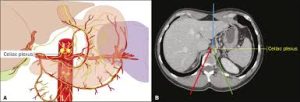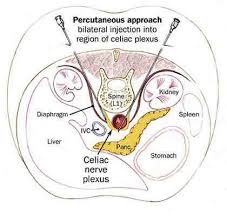

 The celiac plexus, also known as the solar plexus.
The celiac plexus, also known as the solar plexus.
The celiac plexus is a complex network of nerves located in the upper abdomen near where the celiac artery branches from the abdominal aorta.
It plays a role in the autonomic nervous system and is involved in the regulation of various abdominal organs, including the stomach, liver, gallbladder, pancreas, and intestines.
It is a complex network of nerves located in the abdomen, near where the celiac trunk, superior mesenteric artery, and renal arteries branch from the abdominal aorta.
It is behind the stomach and the omental bursa, and in front of the crura of the diaphragm, on the level of the first lumbar vertebra.
The plexus is formed in part by the greater and lesser splanchnic nerves of both sides, and fibers from the anterior and posterior vagal trunks.
The celiac plexus proper consists of the celiac ganglia with a network of interconnecting fibers.
The aorticorenal ganglia are often considered to be part of the celiac ganglia, and part of the plexus.
A strike to the region of the stomach around the celiac plexus is commonly called a blow to the solar plexus.
A blow to this region may cause the diaphragm to spasm, resulting in a sensation commonly known as getting the wind knocked out of you.
A blow to this region may cause pain and interfere with the functioning of the viscera.
A blunt injury to the celiac plexus normally resolves with rest and deep breathing.
A celiac plexus block by means of fluoroscopically guided injection is sometimes used to treat intractable pain from cancers, such as pancreatic cancer or from chronic pancreatitis.
